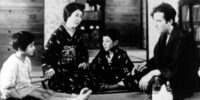I’m one of those people who believe that every film, or any work of art, has a different effect on each individual viewer. Since every one of us is equipped with our own experience, the meaning of what we see is unique for us. In the end, an interpretation is the result of a combination of the artist’s creation and the viewer’s perception. This idea is not just relevant to Michelangelo Antonioni‘s 1966 masterpiece, Blow-Up, but I would say it lies at the core of it, partly because the film allows space for different interpretations, and it deals with the perception of reality or even the possibility of it, but also because this is how the film is built. To me, perhaps the most important feature of Blow-up is its unsteadiness, absence of resolution, and total lack of any fixed point.
The whole film feels like a balancing act. There is no steady state in any of the moments—everything is fluid and constantly moving from one point to its opposite. I mean opposites of all different kinds: reality and imagination, stillness and motion, control and lack of control, existence and non-existence, visible and invisible, black-and-white and colour, surface and depth, observer and observed, and so on. There is no stability. Presentation is followed by its denial; existence is followed by nonexistence. Just when you think you’ve just caught a clear image or definite concept, it immediately starts to turn into its opposite. This tension of opposites is left unresolved in the film. Maybe Antonioni just chose not to offer any clarity to the viewer, which was usually the case with his films, but sometimes these opposites are fundamentally unresolvable.
Cortazar’s Short Story
The notion of opposites has its origin in the film’s literary source. Blow-Up is loosely based on a short story by Julio Cortazar, the original title of which is Las babas del diablo (The Devil’s Drool). The story and the film have many differences. The writer/amateur photographer protagonist of the story is replaced by a professional photographer in the film, the mystery plot is also different with the seduction story being changed to murder, and the time frame is much longer than the 24 hours in the film. But in essence, the stories are very similar, and the theme of opposites is present in both.
It is implied already in the title—Las babas del diablo. Besides its clear negative implication, which makes the reader think of something very bad happening, it is also the name for a natural phenomenon that occurs when young spiders make very thin webs that can disappear in the morning. The story also gives another name for this phenomenon—los hilos de la virgen (the threads of the virgin). Here we have two different names that carry opposite meanings for the same phenomenon. The same object or event is described in opposite ways.
There is also another thing that the babas del diablo hint at—the unreliability of those events. They can disappear like they never existed. You can never have proof of whether they happened or not. It hints at the ephemeral and inconstant nature of reality.
Cortazar’s story has one more distinctive feature—it’s never fully clear who is the narrator, because it’s told sometimes in first-person, and other times in third.
These uncertainties are transferred into Blow-up: there are changes in whose point of view we are seeing and uncertainty about what we are seeing. There is uncertainty about whether what we are seeing is real or is just an imagination, or if there is something that we do not see but that nevertheless exists while having the same impact as very tangible, visible, “real” things.
The balancing act that I’ve mentioned above is not there just for its own sake. While moving from one extreme to another, we observe the surface being removed and another layer revealed, then another, then another. It’s never quite clear which one is real or if there was any real thing at all. It can even feel like bouncing off something that is not really there; if that’s the case, then you have to create some steadiness to bounce off, to rely on, and this steadiness can be the balancing act itself. That’s how I see what Thomas is doing unconsciously until he encounters something that makes him realize it.
Thomas
Blow-up‘s protagonist, Thomas (played by David Hemmings), is a London-based photographer. In a sense, Thomas himself represents a unity of opposites. He is a fashion photographer, works with beautiful models every day, and produces glamorous pictures for magazines, but he also has a side project which consists of capturing the harsh realities of life.
The opposites are present in every aspect of Thomas’ work and life. It’s noticeable even in the sequences where he works in his studio. We watch his work in two sessions: the first, with Verushka, is very dynamic, with both Thomas and Verushka moving constantly, while the other scene involves five models standing behind glass screens, mostly motionless, wearing heavy make-up and looking quite like dolls. It is the opposite of the previous one, in the sense that the models are still, and so is the photographer, who now works with the camera fixed on a tripod. I like to think that the glass screens represent the layers of reality, or perhaps it would be more correct to say layers of illusion.
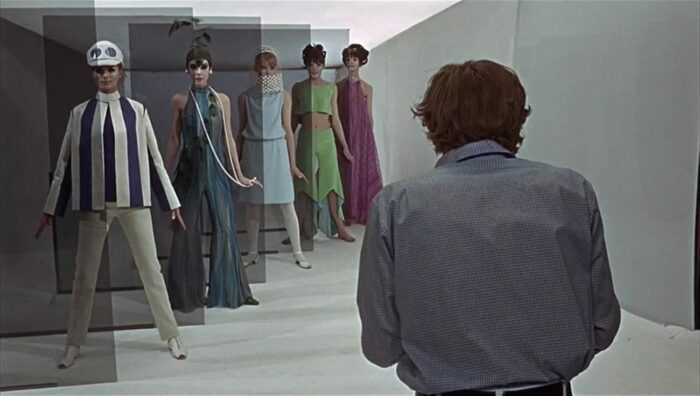
I’ve mentioned Thomas’ side project—when we first see him, he’s leaving a dosshouse with a number of homeless men. He spent the night there to take “real life” photos. Thomas is not content with the superficiality of his work as a fashion photographer and tries to create something more meaningful, to see and capture real life with the help of his camera.
The photos from the dosshouse are intended for his upcoming book, which is going to contain opposites. Thomas wants to end it with, as he says, “very peaceful, very still” photos of a couple he just took in a park. It would make a contrast with the rest of the book, which is, as he says, “pretty violent.” Although the photos from the park will prove to be peaceful only on the surface, in reality, he captured something entirely different, and layer after layer—opposite after opposite—the truth is going to emerge.
The real story goes like this: Thomas saw a couple in a park and took their photos, nothing special, just idyllic images. He was there, saw them, but missed something important, which he notices only after he blows up those photos. In contrast to the film itself and Thomas’ fashion work, which are in colour, these photos are black-and-white. They eventually end up on a studio wall as a small film-like sequence that reproduces the events as they happened. They should’ve been simple and straightforward documents that captured reality—nothing that would imply phantasy of any kind. But even such seemingly straightforward things as black-and-white photographs contain the possibility for doubt and misinterpretation.
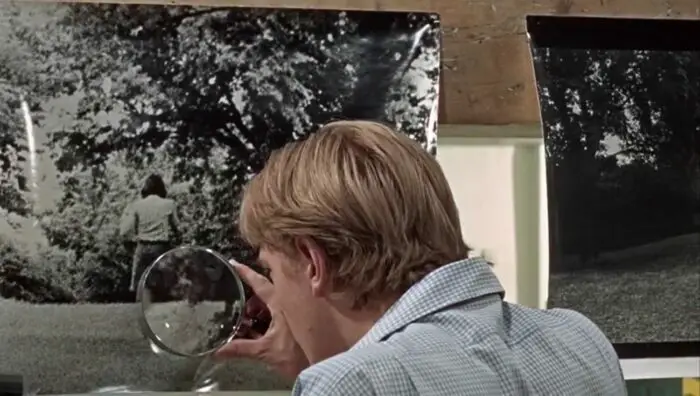
Looking closely, even using a magnifying glass like a detective, Thomas starts to see the details he failed to notice before: a face and a gun behind the trees, which make him conclude at first that he has accidentally prevented a murder. Later, however, he recognizes the body in his photographs, and to his dismay, realizes that he didn’t prevent anything and the murder took place anyway.
Thomas later goes back and finds the body, but even though we see it, there still is some doubt—is it real, or is it Thomas’ imagination? The body looks like a dummy with eyes wide open. At the time, Thomas has no camera with him and cannot take photos of the body. When he returns home, he finds that all the photographs and films are gone except for one blown-up photo that looks more like an abstract picture in which you could see whatever you want. When he goes back to the park the next morning, the body is gone, so he is left without any proof of what happened or if anything happened at all.
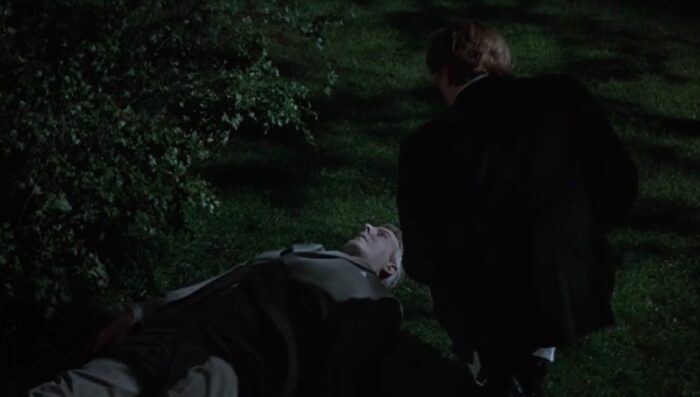
There is one more scene I’d like to mention. It takes place roughly in the middle of the film. Thomas is at his studio with Jane (Vanessa Redgrave), the woman from photos. She has followed him to his studio to claim the photographs. I must admit that this sequence was a little annoying to me initially. Thomas’ usually arrogant behavior is coupled with the artificial, somewhat forced actions of Jane. It is interesting, however, that the whole scene is another example of opposites revealing themselves.
Watching this sequence, there is that feeling that nothing is established and that nothing is reliable here. The scene develops like some kind of pendulum movement; for example, Thomas is supposedly telling Jane about his wife, only to deny it immediately and tell her that she’s not his wife, they just have kids. Then denies that too—no kids, it just feels like they have kids, and so on. Thus, for every statement, its opposite immediately emerges.
At one point, Thomas explains to Jane how to move to Herbie Hancock’s music, which is used as a soundtrack—slowly, “against the beat” is his instruction. Jane, on the other hand, is tensed up and nervous. She has one thing on her mind: get those photographs or her life will turn into a disaster, but she sits there acting as if she’s enjoying the music. As I said above, this scene was annoying until I realized what’s happening here—their actions never express truth, but often the opposite of it. Apparently, these opposites are what ensure stability for Thomas because he seems to be in control, at least up until this moment.
Thomas seems to be balancing on something that is not there, and when he realizes this he is thrown off balance. As it often happens in Antonioni’s films, the essential clue for understanding what is going on is missing, but this doesn’t make things less real, because if we manage to balance on something, even something that doesn’t exist, wouldn’t that make it real?
Mimes
Blow-Up starts and ends with a group of mimes driving around in the streets of London. These opening and closing sequences, among other things, reveal the change that happened in Thomas.
In the opening scene, the mimes are driving and running around streets full of people asking for money. This sequence is important in terms of emphasizing the contrast from the very beginning of the film between the mimes who intentionally play roles and homeless men who are stripped of their social roles. Contrast also exists between mimes and ordinary people like foot guards or nuns who also play their own roles—sometimes wearing respective clothing—without realizing it. Finally, the film compares the mimes with Thomas, who is disguised as a homeless man. The disguised Thomas strives to enter into and capture reality by faking it. One way or another, everyone here is involved in a make-believe game; however, unlike the mimes, it’s not always obvious, and neither is it conscious.

On a closer look, the “real” and “imaginary” do not confront but complement each other. We have Thomas disguised as a homeless man in order to sneak into the reality of other people, while the mimes—obviously fake personae—are asking for real money. Reality and illusion are strangely intertwined and are maybe even integral parts of each other, although Thomas, quite arrogantly, believes that he is living on the “reality” side.
In the ending sequence, Thomas encounters the mimes once again. Mimes start playing tennis with imaginary balls and rackets while Thomas stands outside the fence watching. At one point, the ball flies over the fence, and the mimes turn to ask Thomas to return the ball. Startled at first, Thomas goes to the ball, or to the spot where it should be, takes the ball, and throws it to the mimes.
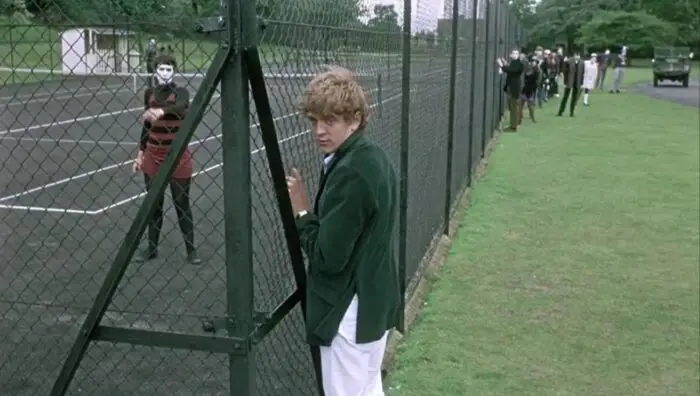
Tennis actually can be viewed as a balancing act, with the ball bouncing from one player to another. When the ball flies off and Thomas is required to return it in the game, he decides to participate. He gets involved in the imaginary game, and now he can even hear the sound of the ball. The final shot of Blow-up is of Thomas standing in the field, slowly disappearing. Does he disappear like the ball or like the body of the murdered man? Does it mean he isn’t real anymore or never was, or on the contrary, is he more real than has ever been? And one more thing—what is truer in this story: what actually happened, or what Thomas has construed in his mind, regardless to what extent these two coincide?

